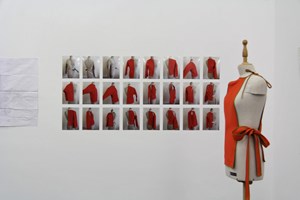
The German artist and this year’s curator Christian Jankowski titled the Manifesta 11 “What People Do for Money – Some Joint Ventures”. By involving the residents of the city and exhibiting the resulting art works all over the city in unexpected locations and contexts he has organized a very amenable and easy approachable biennale in Zurich, Switzerland.
The German artist and this year’s curator Christian Jankowski titled the Manifesta 11 “What People Do for Money – Some Joint Ventures”. By involving the residents of the city and exhibiting the resulting art works all over the city in unexpected locations and contexts he has organized a very amenable and easy approachable biennale in Zurich, Switzerland. For the overall theme ‘work and labour’ he invited international artists to pick a profession from a list of 1000 jobs that are performed everyday in Zurich and following their preferences he matched artists with local hosts. In short, they met in Zürich, the artist got to know the profession and driven by the inspiration took from that meeting the artist created an artwork in cooperation with the local host. The resulting artwork is then exhibited at the host’s workplace and at one of the main exhibition sites the Löwenbräukunst or the Helmhaus and videos shown at the pavilion of reflection on the Zurich lake visualize the process of each joint venture.
Among 30 other artists, Jankowski invited his former professor the German artist Franz Erhard Walther, who is most famous for his process art that invites the viewer to interact with his mostly fabric related art works. For the Manifesta Walther cooperated with the textile developer Thomas Deutschenbaur to create a garment out of Deutschleder. He designed a ‘half vest’ that is worn by the employees of the Park Hyatt hotel. The resulting dress is neither a costume nor a complete outfit, it doesn’t have a function and looks rather unusual as it is like a half jacket with just one sleeve in a bright orange colour. As the viewers’ participation is essential for Walther’s practice the act of wearing the garment completes the actual art work. In a modern five star hotel like the Park Hyatt the unusual outfit could also be misunderstood as a stylish uniform of the employees if signs in the hotel wouldn’t clarify their purpose and explain that this is a satellite happening of the Manifesta. Furthermore Walther’s sketches and instructions are exhibited at the Löwenbräukunst next to photographs of different draft versions by the textile developers. A video by the ‘Art detectives’ at the pavilion of reflections documents the first meeting of Walther and his host, their cooperation process, the final presentation at the Hotel and peoples’ reactions to the art work. For example the textile developer Deutschenbaur emphasizes that they normally have instructions to create functional textiles and for him the interesting experience of the cooperation was to build something functionless. Guests of the hotel who just visit Zürich get in touch with Walther’s ‘half vests’ and come across art where they would expect nor search for it.

Franz Walther, half vest. Löwenbräukunst. Photo © Lavinia Rosen

Franz Erhard Walther, Halbierte Westen (Halved Vests), Löwenbräukunst. Photo (c) Manfesta11/Wolfgang Traeger

Franz Walther, halbierte. Weste Park Hyatt Hotel. Photo © Lavinia Rosen

Franz E. Walther, half vest. Pavillion of refelctions. Lavinia Rosen Photo © Lavinia Rosen
It is this involvement of non-art professionals and their interpretation of the art world that make this Manifesta so successful. It opens up space to question everyday life, space to experience and interpret art in different contexts and vice versa provides a platform to look at contemporary art from an outside non-art perspective. Overall this results in a quite humorous and easy-accessible biennale.

ArtDependence Magazine is an international magazine covering all spheres of contemporary art, as well as modern and classical art.
ArtDependence features the latest art news, highlighting interviews with today’s most influential artists, galleries, curators, collectors, fair directors and individuals at the axis of the arts.
The magazine also covers series of articles and reviews on critical art events, new publications and other foremost happenings in the art world.
If you would like to submit events or editorial content to ArtDependence Magazine, please feel free to reach the magazine via the contact page.